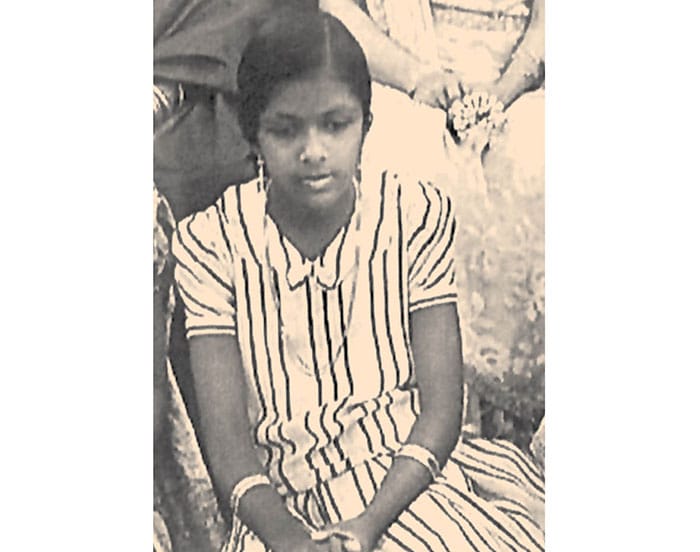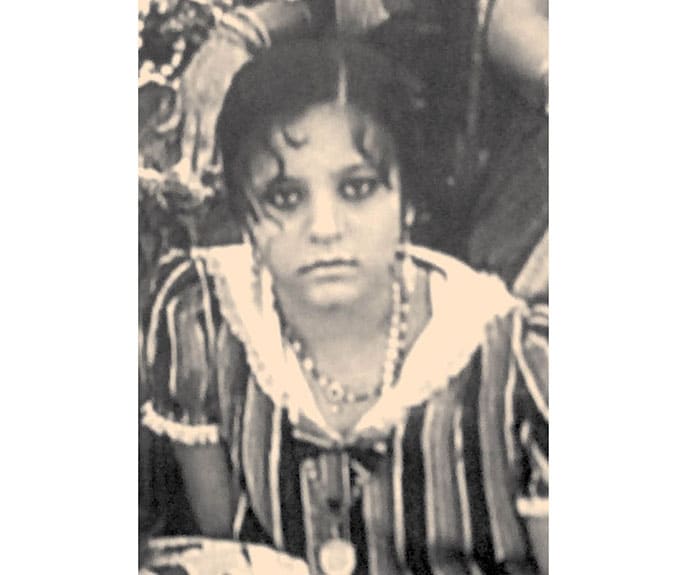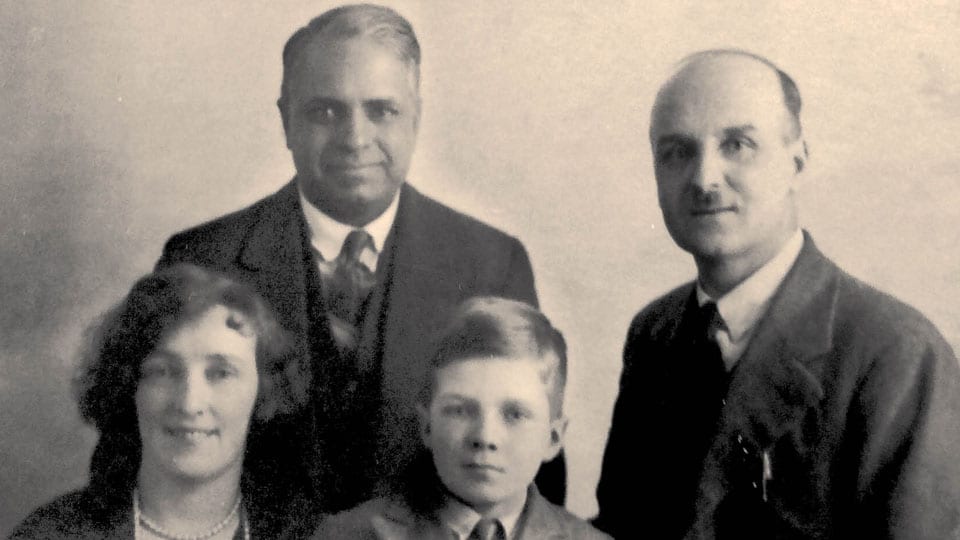By Girija Madhavan
Many of us elderly folk are now sequestered at home. The television focuses on COVID-19, with its seemingly sentient malice against humanity, or the tragedy of Afghanistan. Books, music and films are a comfort. But nothing can compare with the companionship of friends.
“Visiting” was an enjoyable social activity in old Mysore when friends paid “calls” on one another. My father was an engineer of the Mysore State Railways. We lived in the first of the railway bungalows on KRS Road, my childhood home. This was our first social circle.
These memories are from my childhood, others garnered from family lore. A very early recall is of the morning visits of “Bahadur” [the only name I knew him by], an Ursu friend of my father. He would ride into the garden after his morning gallop, wheeling his horse to a stop at the portico. Bahadur always stayed outside, chatting with my father, patting the restive animal.
My parents, M. Venkatesh and Mukta Venkatesh, spoke of Mr. Sinclair, the English General Manager of the Mysore State Railways. Mrs. Sinclair was sociable and attended the meetings of the Bharati Sthree Samaja of the Railways. Their niece, Miss Morgan, from England would visit my parents with her pet dachshund, Charlie. On her farewell call, Miss Morgan was in tears; English quarantine rules forbade her to take Charlie back with her. He was left behind, a lonely English dog in Vontikoppal’s Railway enclave.

After the Sinclairs, came Rohinton and Diana Mirza. Fusing Parsi styles and western fashion, Mrs. Diana Mirza was an exotic personality. Her unmarried sisters were the Kotawalas, Nurgesh who wrote poetry, Zarina who contributed society news to a newspaper. My mother served them cake from Hamza Bakery on Sayyaji Rao Road and tea from her green and white Gwalior pottery tea-set. Embroidered napkins, once bought from itinerant Chinese salesmen in Madras in the 1920s, were taken out too.
More traditional ladies like Mrs. Y.K. Ramachandra Rao or Mrs. Ramanujam with her daughters Malathi and Lalitha, would drop in, politely refusing refreshment. When they left, they were offered kumkum, reverentially applied to the forehead, turmeric touched to the throat. Coconuts placed on betel leaves, areca nuts, flowers and sometimes a length of silk [Khana] were also given. They parted with the graceful Karnataka goodbye, “I will go and come back” [Hoggiddu baruthene].
Tripurasundari Devi [the wife of Sri D.V. Narasimha Rao who established the National Institute of Engineering] and Srimati Gowramma Gundappa and their families were our close friends.
Sri M. Ramaiah’s family continues a cherished relationship. We knew the late Dr. Narayan Shetty and Dr. Govind Shetty. I often accompanied my mother to “Harishina-Kumkuma” [festival invites] at Mrs. Ramaiah’s home, meeting her daughters, Mrs. Narayana Shetty [Ammaiah], Jayamma and Shakuntala. Dr. Bhaskar, Dr. Rajeshwar and their families were close to my mother.

Sister John of the Good Shepherd Convent had a Railway connection. Her father, Mr. Dorechetty was a Railway colleague. Beloved for her good nature and admired for her prowess in both Western and Karnatak music, Sister John was always warmly welcomed.
Outside the Railway circle were Professor M.V. Gopalaswamy [of Akashvani fame] and Kamala Gopalaswamy. The latter and Mukta were sometimes mistaken for each other because of their startling resemblance. Sitting in his favourite chair under the fan, Professor Gopalaswamy would talk about Psychology, the radio and other topics. I still recall his recounting an anecdote about experiments on chimpanzees, where mother love and self preservation were in conflict.
At the end of Vivekananda Road stands, unchanged, the house of Dr. H.V. Ramaswamy and Parvathamma. He was a well-known doctor, also affiliated to the Mysore Palace. The daughters were Kamala and Kaveri.The latter’s wedding to Dr. Gopal, the son of Dr. S. Radhakrishnan, was a great event in Yadavagiri. She was named “Indira” after her marriage. When Mukta visited Delhi, she was invited by Indira Gopal to Rashtrapati Bhavan. She said this was “the grandest visit I ever paid.”
Mukta, always informal, called on a doctor friend, grabbing the gardener’s shabby umbrella against the sudden monsoon rain. The doctor’s children were at the door. Before admitting Mukta, they asked doubtfully, “Are you an Aunty or an Ayah? You sound like an Aunty but you have an Ayah’s umbrella.”
Mrs. Leela Anjanappa, wife of a businessman, was a well-known personality. She headed the Girl Guide movement in Mysore, receiving the Silver Elephant award in recognition. She also did social work, starting an organisation called Makkala Koota for poor children. She had a following as an elegant lady, setting standards for “morning and evening wear.” Admirers noted her dress at her public appearances.
Friends from Mysore University like Professor and Mrs. V.L. D’Souza, their daughter Joan and, occasionally Professor Eagleton, a brilliant speaker, would call. Eagleton was known to his irreverent students as “Garudachar.” Father Audiau was the Principal of St. Philomena’s College, his tenure ending in 1956. A tall Frenchman with a stubby silvery beard, he was a commanding presence in his white cassock. His fluent English was accented by his native French, best understood by Mukta.
Kamesweramma Kuppuswamy was a social reformer, her husband, Professor Kuppuswamy, taught Psychology at Mysore University. She worked for widow remarriage and women’s’ education. She established the “Mathrumandali” which functions to this day. In appreciation of her social work, a road was named “Geetha Road” after her first daughter, Geetha, was born. It is there even now but its origins are forgotten.

Dr. Kale, a scientist with the CFTRI and his Polish wife were popular in Mysore society. Their daughter, Lalitha [Lily], was the most beautiful woman I have ever seen. There was always a hint of sadness in Mrs. Kale’s eyes. She had lost her entire family in Poland during the war. Lily married the mathematician Dr. Harish Chandra. The wedding luncheon, held in Hotel Metropole, was elegant; served in English style with courses accompanied by wines, with champagne for the toast. The couple went to Yale in the US. Dr. Kale passed away sometime later but Mrs. Kale stayed on in Mysore with her pet dogs, Zippy and Fifi.
My mother and I visited a home called “The Land,” belonging to the Van Ingens, the well-known taxidermists. Our hostess was Barbara Van Ingen, the wife of Botha Van Ingen. Her father was the director, Robert J. Flaherty, who produced the 1937 film, “Elephant Boy” starring Sabu in Mysore. Barbara was creative; she displayed a vivid sketch of her father playing the violin and her other paintings. She became a close friend of Mukta, visiting her in Yadavagiri, writing often after she left for the US. Her son, Mike Van Ingen, is also a talented artist who makes vivid paintings of wild life, particularly elephants.
Life then was a microcosm of India. The friends we interacted with so happily are now regarded as luminaries of their time, representing the unique values of our city of Mysore. That world is lost, only these transient images bringing it back to a fleeting life.








Very interesting, since I was born and brought up in yadavagiri. The narrative sounds very familiar.
I read this piece of travel back through the memory lane.
First, I should correct the terminology. ‘Old Mysore’ referred to the state that existed before the unification (Ekikarana) of Karnataka in 1956, and the City then, hence, was not referred to with that name.
The visits of friends and relatives, in my experience, were during the glorious 10 days of Dasara, when the City was transformed with regal grandeur ; the Mysore Palace events every day in the evening before the Maharaja ascended the throne, the Palace lighting following, and the Exhibition at the medical college building attracted visitors , even before the grand Jamboo Savari march. Any memory lane narrative, albeit of visiting friends, local/from elsewhere surely should at least mention the above, a time in the years long past where friends visit in the holiday period of the Dasra.
The MSR (Mysore State Railway), became Southern Railway in 1950s. DV Narannsimha Rao mentioned there was the chief engineer in MSR, and no wonder she knew him. He and Sarvepalli Rafdhakrishan were parents-in-laaw.
Dropping of names of doctors and university professors. I wonder, how a railway engineer, entrusted with the maintenance of railway tracks and , and bridges, and hence was on trips very often in the regions covered by the MSR was managed to befriends ranging from medical specialists ( MSR had its own HQ hospital and doctors in Yadavagiri) in KR Hospitals to professors such as Eagleton! A line or two explanation would have given authenticity.
It would have been better if the time periods were identified. For example Professor Eagleton and Professor JC Rollo of Mharajas College left soon after independence. I suspect, this author must be about my age, or a bit older. Her narrative seems a mix of time periods from 1950 or so to about late 1960s; reading about Dr Govinda Shetty t was the physician and the cardiologist at the KR Hospital in during 1950s, who died of heart attack in that period, and his nephew Dr Bhasker who was a doctor in late 1960s, qualified in AIIMS. A generational gap!
The best approach to such narrative is to divide the periods, identifying the events of visits tin each and sum up at the end, those glorious days of this Royal City.. I recommend, reading Sir C P Ramaswamy Iyer’s superb book: Biographical Vistas’, if one could get a copy, where he narrated about his friends and others so well dividing the Vistas into time periods.
Finally, people of my vintage, tend to read books. There are plenty of free ebooks which could keep an elderly person busy. In the West, Covid 19 and the lockdowns, have encouraged the habit of reading ebooks, to those of my generation, who did not do so in earlier decades
I hate to say this about this article. It is a pathetic account of names dropping of the rich mixed with fantasy and myth-based moan about those good old days involving the upper middle class bunch. Not a sentence of this woman’s friends who are the daughters of railway track maintenance workers, who got up early in the morning and walked miles fixing loose sleepers and tightening the bolts that hold the rails, 7 days a week rain or shine. It was hard slog manual work for them in the absence of appropriate tools and clothing. For this they were given third class passes to travel in crowded third class compartments.
One could see the worst of officer class in railways those days. I should know as I had the first hand experience of a relative who was one, and had no knowledge of how passengers suffered in crowded third class compartments even in those days.
Even to day, in the West, whenever, an overstaffed and inefficient public service needs an example, Indian railways is cited every time!
Railway officers in those days, I am sure even now, have had the job for life, getting first class passes for their family, and even their windows got them for life , while the miserable third class (( now renamed as second class!) passengers travelled in crowded compartments.
Even in 1950s, such a contrast to Sir MV’s team of efficient civil engineers, the civil engineers in Mysore State Railway ( MSR) in those days. They were simply not up to the job or any challenge- the fiasco of badly maintained Lokapavani bridge between Mysuru and Bengaloru line as well as the track leading to it from the Bengalore, which resulted in a massive accident involving a crowded express train from Bengaluru in 1950 or there about, was a very good example. It is still fresh in my memory, a middle schooler, as a family of my friends were involved in that accident.. Until the Southern Railway was formed, and the arrival of competent engineers from other parts of the South, the state of that bridge and that track remained the same. These new engineers quickly deployed a relatively modern bridge with steel girders adjacent to the old bridge thus diverting the rail track over to it. The railway engineers of then Mysore State Railways meanwhile carried on enjoying their luxury railway travels in the first class compartments served with free lunch and dinner , living in free large bangalows in Yadavagiri as a perk.
While the then Mysore state could be proud of the achievements of Sir MV, and his team of engineers, that cannot be said of their MSR counterparts.
Apologies for a few typos.